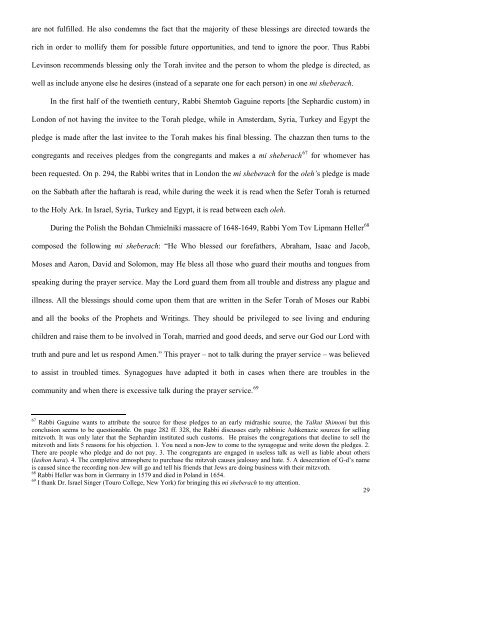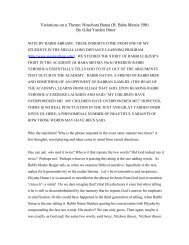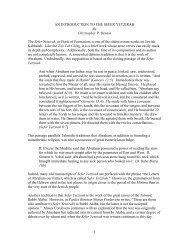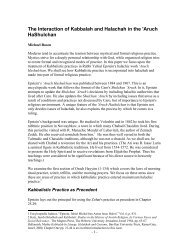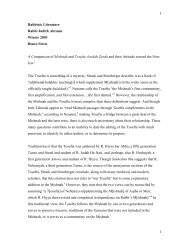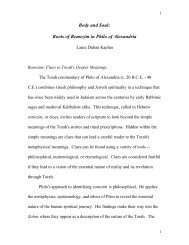The Symbolic Representation of the Sefer Torah - Maqom
The Symbolic Representation of the Sefer Torah - Maqom
The Symbolic Representation of the Sefer Torah - Maqom
Create successful ePaper yourself
Turn your PDF publications into a flip-book with our unique Google optimized e-Paper software.
are not fulfilled. He also condemns <strong>the</strong> fact that <strong>the</strong> majority <strong>of</strong> <strong>the</strong>se blessings are directed towards <strong>the</strong>rich in order to mollify <strong>the</strong>m for possible future opportunities, and tend to ignore <strong>the</strong> poor. Thus RabbiLevinson recommends blessing only <strong>the</strong> <strong>Torah</strong> invitee and <strong>the</strong> person to whom <strong>the</strong> pledge is directed, aswell as include anyone else he desires (instead <strong>of</strong> a separate one for each person) in one mi sheberach.In <strong>the</strong> first half <strong>of</strong> <strong>the</strong> twentieth century, Rabbi Shemtob Gaguine reports [<strong>the</strong> Sephardic custom) inLondon <strong>of</strong> not having <strong>the</strong> invitee to <strong>the</strong> <strong>Torah</strong> pledge, while in Amsterdam, Syria, Turkey and Egypt <strong>the</strong>pledge is made after <strong>the</strong> last invitee to <strong>the</strong> <strong>Torah</strong> makes his final blessing. <strong>The</strong> chazzan <strong>the</strong>n turns to <strong>the</strong>congregants and receives pledges from <strong>the</strong> congregants and makes a mi sheberach 67 for whomever hasbeen requested. On p. 294, <strong>the</strong> Rabbi writes that in London <strong>the</strong> mi sheberach for <strong>the</strong> oleh’s pledge is madeon <strong>the</strong> Sabbath after <strong>the</strong> haftarah is read, while during <strong>the</strong> week it is read when <strong>the</strong> <strong>Sefer</strong> <strong>Torah</strong> is returnedto <strong>the</strong> Holy Ark. In Israel, Syria, Turkey and Egypt, it is read between each oleh.During <strong>the</strong> Polish <strong>the</strong> Bohdan Chmielniki massacre <strong>of</strong> 1648-1649, Rabbi Yom Tov Lipmann Heller 68composed <strong>the</strong> following mi sheberach: “He Who blessed our forefa<strong>the</strong>rs, Abraham, Isaac and Jacob,Moses and Aaron, David and Solomon, may He bless all those who guard <strong>the</strong>ir mouths and tongues fromspeaking during <strong>the</strong> prayer service. May <strong>the</strong> Lord guard <strong>the</strong>m from all trouble and distress any plague andillness. All <strong>the</strong> blessings should come upon <strong>the</strong>m that are written in <strong>the</strong> <strong>Sefer</strong> <strong>Torah</strong> <strong>of</strong> Moses our Rabbiand all <strong>the</strong> books <strong>of</strong> <strong>the</strong> Prophets and Writings. <strong>The</strong>y should be privileged to see living and enduringchildren and raise <strong>the</strong>m to be involved in <strong>Torah</strong>, married and good deeds, and serve our God our Lord withtruth and pure and let us respond Amen.” This prayer – not to talk during <strong>the</strong> prayer service – was believedto assist in troubled times. Synagogues have adapted it both in cases when <strong>the</strong>re are troubles in <strong>the</strong>community and when <strong>the</strong>re is excessive talk during <strong>the</strong> prayer service. 6967 Rabbi Gaguine wants to attribute <strong>the</strong> source for <strong>the</strong>se pledges to an early midrashic source, <strong>the</strong> Yalkut Shimoni but thisconclusion seems to be questionable. On page 282 ff. 328, <strong>the</strong> Rabbi discusses early rabbinic Ashkenazic sources for sellingmitzvoth. It was only later that <strong>the</strong> Sephardim instituted such customs. He praises <strong>the</strong> congregations that decline to sell <strong>the</strong>mitzvoth and lists 5 reasons for his objection. 1. You need a non-Jew to come to <strong>the</strong> synagogue and write down <strong>the</strong> pledges. 2.<strong>The</strong>re are people who pledge and do not pay. 3. <strong>The</strong> congregants are engaged in useless talk as well as liable about o<strong>the</strong>rs(lashon hara). 4. <strong>The</strong> completive atmosphere to purchase <strong>the</strong> mitzvah causes jealousy and hate. 5. A desecration <strong>of</strong> G-d’s nameis caused since <strong>the</strong> recording non-Jew will go and tell his friends that Jews are doing business with <strong>the</strong>ir mitzvoth.68 Rabbi Heller was born in Germany in 1579 and died in Poland in 1654.69 I thank Dr. Israel Singer (Touro College, New York) for bringing this mi sheberach to my attention.29


